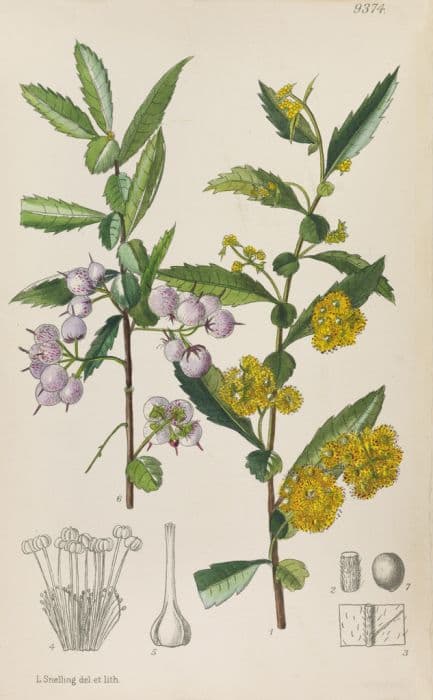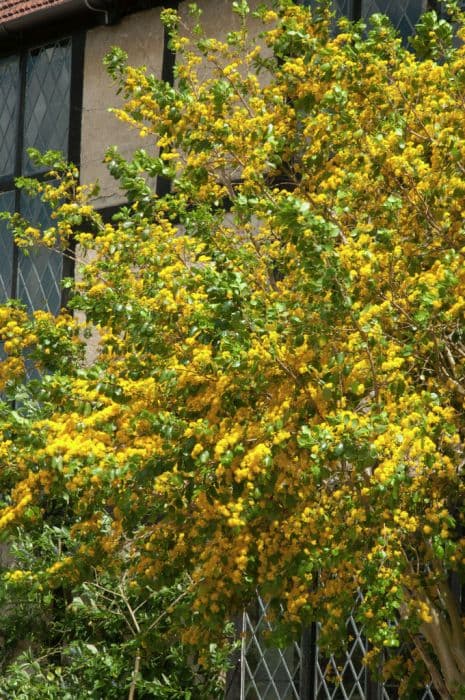Southwestern Willow Salix irrorata

ABOUT
Salix irrorata, commonly known as the Blue-stem Willow, is a deciduous plant characterized by its striking growth habit and overall appearance. It boasts slender, elongated leaves that typically have a lush green hue, which can turn golden yellow in the fall before they drop. The leaves generally give off a glossy or shiny appearance on the upper side, while the underside may seem slightly paler and often possess a soft, delicate texture. The stems and branches of the Blue-stem Willow are one of its most distinctive features, as they can exhibit a blue-gray tone, providing a stark but beautiful contrast against the foliage and creating a unique visual interest in the landscape. The bark on these branches is typically smooth, adding to the plant's refined look. During the blooming season, the Blue-stem Willow produces catkins, which are flower clusters that can either be slender and elongated or more compact, depending on the gender of the plant, as it is dioecious with male and female flowers on separate plants. The catkins add to the ornamental value of the plant, often emerging with a soft, silvery appearance before maturing to a yellow or green color. Overall, the appearance of the Blue-stem Willow is marked by its graceful leaves, colorful stems, and attractive catkins which, together, create a scenic impression that can enhance any garden or natural setting.
About this plant
 Names
NamesFamily
Salicaceae
Synonyms
Southwestern Willow, Blue Stem Willow
Common names
Salix irrorata.
 Toxicity
ToxicityTo humans
Salix irrorata, commonly known as the southwestern willow, is not typically known for being poisonous to humans. Members of the Salix genus, which includes willows, are often recognized for their medicinal properties, such as salicylic acid, which is the basis for aspirin. However, consuming large quantities of willow bark or leaves could potentially lead to adverse effects similar to aspirin overdose, such as stomach pain, nausea, vomiting, or more severe symptoms in very large doses. It is always advisable to consult with a healthcare professional if there is a concern about plant ingestion or poisoning.
To pets
Salix irrorata, known as the southwestern willow, is not generally listed as toxic to pets. Willows are not commonly associated with pet toxicity, and they are often used in natural remedies for pain relief due to their salicylic acid content. However, as with any non-food plant, ingestion of large amounts could potentially cause mild gastrointestinal upset in some pets, such as vomiting or diarrhea. If a pet ingest large amounts of the plant and shows adverse symptoms, it is advisable to contact a veterinarian.
 Characteristics
CharacteristicsLife cycle
Perennials
Foliage type
Deciduous
Color of leaves
Green
Height
20 feet (6 meters)
Spread
20 feet (6 meters)
Plant type
Tree
Hardiness zones
4
Native area
South America
Benefits
 General Benefits
General Benefits- Erosion control: Salix irrorata, commonly known as Blue Stem Willow, is often used in riparian zones to stabilize soil and prevent erosion due to its robust root system.
- Habitat creation: It provides a natural habitat for wildlife, including birds, small mammals, and insects, thereby supporting biodiversity.
- Windbreaks and shelter: Blue Stem Willow can be used as a windbreak to protect crops and as shelter for livestock due to its dense growth.
- Ornamental use: With its striking blue-green stems and foliage, it is frequently planted for ornamental purposes in landscaping projects.
- Soil improvement: As a willow species, it can contribute to improving soil quality through the buildup of organic matter from its leaf litter.
- Climate adaptation: Being a willow, it is typically resilient to variations in water levels, making it suitable for areas with fluctuating climates.
- Streambank stabilization: Its strong roots can help to stabilize streambanks and reduce the effects of flooding.
 Medical Properties
Medical Properties- Anti-inflammatory: The bark of the willow tree, which includes Salix irrorata, contains salicin, a compound known to reduce inflammation.
- Analgesic: Salicin is also recognized for its pain-relieving properties once metabolized into salicylic acid in the body.
- Antipyretic: Willow bark has traditionally been used to reduce fever, thanks to its salicin content.
- Rheumatism treatment: Due to its anti-inflammatory effects, willow bark extracts are sometimes utilized in herbal medicine to ease rheumatic aches and pains.
- Headache relief: The natural precursors to aspirin found in the bark of Salix irrorata can help alleviate headaches.
 Air-purifying Qualities
Air-purifying QualitiesThis plant is not specifically known for air purifying qualities.
 Other Uses
Other UsesAs a source of fiber: The bark of the Southwestern Willow can be used to extract fibers for making textiles or paper products.
Instrument crafting: The wood of the Southwestern Willow is occasionally employed by artisans to create musical instruments such as flutes and pipes.
Livestock fodder: Leaves of the Southwestern Willow can be fed to livestock as a supplementary diet during times when other forage is scarce.
Natural dyes: The bark, leaves, or catkins can be boiled to produce natural dyes for textiles or crafts.
Basketry: Flexible young shoots from the Southwestern Willow can be woven into baskets and other forms of decorative and practical wickerwork.
Streambank stabilization: Southwestern Willow's extensive root system helps to prevent soil erosion along riverbanks and stabilizes the soil in riparian zones.
Environmental art: Artists may use the branches and trunks in creating environmental sculptures or installations.
Charcoal production: Wood from the Southwestern Willow can be converted into charcoal, which is used for drawing or fuel.
Wildlife habitat: Southwestern Willow thickets provide important nesting and hideaway spots for various species of birds and small mammals.
Beekeeping attractant: The catkins produce pollen that is attractive to bees, helping beekeepers to establish or maintain healthy hives.
Interesting Facts
 Feng Shui
Feng ShuiThe South American Willow is not used in Feng Shui practice.
 Zodiac Sign Compitability
Zodiac Sign CompitabilityThe South American Willow is not used in astrology practice.
 Plant Symbolism
Plant Symbolism- Flexibility: The flexible branches of the Salix irrorata, commonly known as the Southwestern Willow, symbolize adaptability and resilience, demonstrating the ability to bend without breaking.
- Growth & Renewal: As a willow species, its association with water and lush growth represents renewal and the continuous cycle of life's seasons.
- Healing: Traditionally, willows have been used for their medicinal properties, and this species is no exception, symbolizing healing and the soothing of pain.
- Intuition: Willows are often connected to the moon and water, embodying intuition, deep emotions, and the subconscious.
- Grief: In some cultures, the weeping form of willow trees is linked to mourning, offering comfort and a place to process loss.
 Water
WaterThe Southwestern Willow (Salix irrorata) prefers consistent moisture, so it should be watered when the top inch of soil feels dry to the touch. Depending on the climate and weather conditions, this may mean watering once or twice a week. Use a slow and thorough watering method, allowing water to penetrate deeply into the soil, encouraging the roots to grow downward. A mature Southwestern Willow may require about 5 gallons of water per week during the growing season, but always adjust the amount based on rainfall and temperature.
 Light
LightSouthwestern Willow thrives best in full sun to partial shade. It should be planted in a location where it can receive at least 6 hours of direct sunlight per day, while some afternoon shade is beneficial in areas with hot summers. The best spot for this willow would be an open area with ample space for its spreading growth habit, ensuring it receives sufficient light throughout the day.
 Temperature
TemperatureThe Southwestern Willow is hardy and can withstand a range of temperatures, typically between 10°F and 90°F. Ideally, it prefers to grow in temperatures that are between 50°F and 80°F. Extreme heat or sudden frost may stress the plant, so it's advisable to provide protection or supplemental water during these periods to help the tree maintain its health.
 Pruning
PruningPruning the Southwestern Willow is important to maintain its shape, remove damaged branches, and promote healthy growth. Pruning should be done in late winter or early spring, before the beginning of the growing season. Remove any dead, diseased, or broken branches, as well as any that are crossing or rubbing against each other. It's also advisable to thin out dense growth to allow light and air to penetrate the canopy, which can be done every few years.
 Cleaning
CleaningAs needed
 Soil
SoilThe Southwestern Willow, Salix irrorata, thrives best in moist, well-draining soil with a pH range from 6.0 to 7.5. A good soil mix for this willow consists of equal parts loam, sand, and peat moss to ensure proper moisture retention and drainage. Regular organic matter enrichment can benefit its growth.
 Repotting
RepottingSouthwestern Willow should ideally be repotted every two to three years to prevent it from becoming root-bound and to replenish its soil. Younger willows may require more frequent repotting as they grow more rapidly.
 Humidity & Misting
Humidity & MistingThe Southwestern Willow prefers moderate to high humidity levels but is adaptable to a range of humidity conditions as long as it receives adequate watering and has good soil moisture.
 Suitable locations
Suitable locationsIndoor
Position Southwestern Willow in bright light and keep soil moist.
Outdoor
Plant in sunny location with access to water; mulch to retain moisture.
Hardiness zone
4-8 USDA
 Life cycle
Life cycleSalix irrorata, commonly known as Blue-stem Willow, begins its life cycle with seed germination, typically taking place in moist soil conditions along riverbanks or floodplains. The seeds rapidly grow into young seedlings, which require ample sunlight and water to thrive. As the seedlings mature, the Blue-stem Willow develops into a shrub or small tree, with a distinctive blue-tinted stem and elongated, narrow leaves. It enters a stage of vegetative growth, producing catkins (flowering spikes) in early spring that are pollinated by wind, leading to seed development. Once pollinated, the catkins form capsules that release seeds, poised to germinate and start the next generation. Throughout its life, the Blue-stem Willow can also propagate vegetatively through root suckers or branch cuttings, creating dense thickets that stabilize soil and support local ecosystems.
 Propogation
PropogationPropogation time
Early Spring
The most popular method of propagation for the Southwestern Willow (Salix irrorata) is through cuttings. This is usually done during the plant's dormancy period which is typically in late winter to early spring. For successful propagation, one would take cuttings of new growth, about 6 to 10 inches long, ensuring that several nodes are present on the cutting. These cuttings are then inserted into a mix of soil and perlite or directly into the ground where they are to grow. The base of the cuttings should be kept moist until rooted, which can take a few weeks to several months depending on the conditions. This method of propagation is favored for its simplicity and effectiveness, allowing gardeners and restorers to produce multiple trees from a single specimen.









